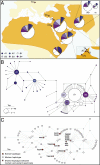Ancient and modern DNA reveal dynamics of domestication and cross-continental dispersal of the dromedary
- PMID: 27162355
- PMCID: PMC4914195
- DOI: 10.1073/pnas.1519508113
Ancient and modern DNA reveal dynamics of domestication and cross-continental dispersal of the dromedary
Abstract
Dromedaries have been fundamental to the development of human societies in arid landscapes and for long-distance trade across hostile hot terrains for 3,000 y. Today they continue to be an important livestock resource in marginal agro-ecological zones. However, the history of dromedary domestication and the influence of ancient trading networks on their genetic structure have remained elusive. We combined ancient DNA sequences of wild and early-domesticated dromedary samples from arid regions with nuclear microsatellite and mitochondrial genotype information from 1,083 extant animals collected across the species' range. We observe little phylogeographic signal in the modern population, indicative of extensive gene flow and virtually affecting all regions except East Africa, where dromedary populations have remained relatively isolated. In agreement with archaeological findings, we identify wild dromedaries from the southeast Arabian Peninsula among the founders of the domestic dromedary gene pool. Approximate Bayesian computations further support the "restocking from the wild" hypothesis, with an initial domestication followed by introgression from individuals from wild, now-extinct populations. Compared with other livestock, which show a long history of gene flow with their wild ancestors, we find a high initial diversity relative to the native distribution of the wild ancestor on the Arabian Peninsula and to the brief coexistence of early-domesticated and wild individuals. This study also demonstrates the potential to retrieve ancient DNA sequences from osseous remains excavated in hot and dry desert environments.
Keywords: Camelus dromedarius; anthropogenic admixture; demographic history; paleogenetics; wild dromedary.
Conflict of interest statement
The authors declare no conflict of interest.
Figures



Comment in
-
Back to the roots and routes of dromedary domestication.Proc Natl Acad Sci U S A. 2016 Jun 14;113(24):6588-90. doi: 10.1073/pnas.1606340113. Epub 2016 May 25. Proc Natl Acad Sci U S A. 2016. PMID: 27226295 Free PMC article. No abstract available.
-
Note on the contribution of genetics to understanding the organization of camel caravans in antiquity.Proc Natl Acad Sci U S A. 2016 Aug 9;113(32):E4582. doi: 10.1073/pnas.1609773113. Epub 2016 Aug 2. Proc Natl Acad Sci U S A. 2016. PMID: 27486243 Free PMC article. No abstract available.
Comment on
-
Back to the roots and routes of dromedary domestication.Proc Natl Acad Sci U S A. 2016 Jun 14;113(24):6588-90. doi: 10.1073/pnas.1606340113. Epub 2016 May 25. Proc Natl Acad Sci U S A. 2016. PMID: 27226295 Free PMC article. No abstract available.
References
-
- Bulliet R. The Camel and the Wheel. Columbia Univ Press; New York: 1975. p. 327.
-
- Faye B, Grech S, Korchani T. Le dromadaire, entre féralisation et intensification. Anthropozoologica. 2004;39(2):391–398.
-
- Wu H, et al. Camelid genomes reveal evolution and adaptation to desert environments. Nat Commun. 2014;5:5188. - PubMed
-
- Peters J, von den Driesch A. The two-humped camel (Camelus bactrianus): New light on its distribution, management and medical treatment in the past. J Zool (Lond) 1997;242:651–679.
Publication types
MeSH terms
Substances
Associated data
- Actions
- Actions
- Actions
- Actions
- Actions
- Actions
Grants and funding
LinkOut - more resources
Full Text Sources
Other Literature Sources

